Question
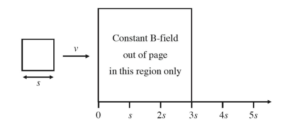
A square loop of conducting wire with sides is moved at a constant rate v to the right into a region where there is a constant magnetic field directed out of the page. Which of the following graphs shows the flux through the loop as a function of distance?
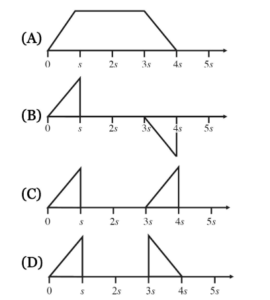
▶️Answer/Explanation
Ans:A
Flux is the product of the area enclosed by the loop of wire and the field strength. The flux will increase linearly up to a maximum value when the wire is completely within the field, and will begin to decrease once the wire begins to leaves the region within the field.
Question
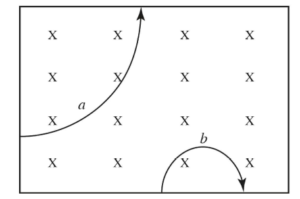
A machine shoots a proton, a neutron, or an electron into a magnetic field at various locations. The paths of two particles are shown above. Assume they are far enough apart so that they do not intersect and the magnetic field is going out of the page, as shown. What can you say about the paths that represent each particle?
(A) a is the proton and b is the electron.
(B) bis the proton and a is the electron.
( C) Either may be a neutron.
(D) You cannot make any conclusions without knowing the velocities.
▶️Answer/Explanation
Ans:A
Path a follows the right-hand rule so must be positively charged. Path b is opposite the right hand rule so must be negatively charged. Neutrons would follow a straight line
path, so it is impossible for either a or b to be a neutron.
Question
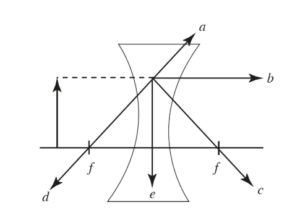
In the figure above, a ray of light hits an object and travels parallel to the principal axis as shown by the dotted line. Which line shows the correct continuation of the ray after it hits the concave lens?
(A) a
(B) b
(C) c
(D) d
▶️Answer/Explanation
Ans:A
The rules for ray-tracing diagrams state that a line parallel to the principle axis bends away from the focal point as shown.
Question
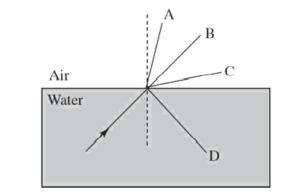
A beam of light goes from water to air. Depending on the actual angle that the light strikes the surface, which of the following rays are possible outcomes?
(A) A only
(B) B only
(C)A or D
(D) C or D
▶️Answer/Explanation
Ans:D
Water has a higher index of refraction than air, so if light refracts through the water the light will bend away from the normal-so C is possible. Another possibility is D, total internal reflection when the angle in water is greater than the critical angle.
Question
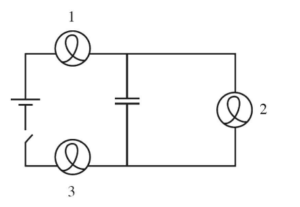
The circuit above contains a battery, a switch, three identical light bulbs, and a capacitor. The capacitor is initially uncharged. The instant the switch is closed, which of the bulbs are lit?
(A) All three bulbs are unlit.
(B) Only bulb 1 is lit.
( C) Only bulb 2 is lit.
(D) Bulb 1 and bulb 3 are lit.
▶️Answer/Explanation
Ans:D
The uncharged capacitor acts as a wire, shorting bulb 2. A complete loop is made consisting of bulb 1, the capacitor, and bulb 3.
